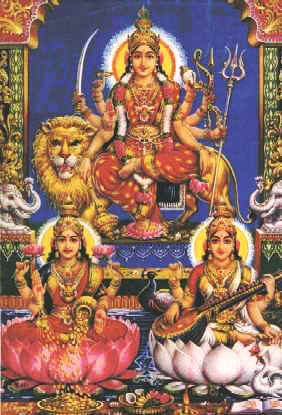Significance of Navaratri

By V.N. Gopalakrishnan
Navaratri (nine nights) is a Hindu festival celebrated during the month of Asvin (September-October). The festival is celebrated for nine days commencing from September 19 and concluded on September 27, this year. It symbolises the triumph of good over evil and is dedicated to Durga, the mother Goddess who also represents power. Durga annihilated the buffalo-headed demon Mahishasura after a relentless battle lasting nine days. Hence Navaratri is also known as Durga Puja. During this period, Goddess Durga, Goddess Lakshmi and Goddess Saraswati are worshipped as three different manifestations of Shakti, or cosmic energy. It is a period of introspection and is traditionally considered as auspicious time for starting new ventures.
It is said that Shiva gave permission to Durga to see her mother for nine days in a year and the festival is reminiscent of this visit. To celebrate a good harvest and to propitiate the nine planets, women also plant nine different kinds of food grain seeds in small pots during these days and then offer the young saplings to the goddess.
During Navaratri, some devotees observe a fast and prayers are offered to Durga. The most colourful and elaborate celebrations are held in Bengal and Assam, where huge idols of the goddess are worshipped daily and taken in jubilant processions in nearby rivers or reservoirs for immersion. Feasts are offered to guests and family during the festival.
In Andhra Pradesh, the festival is known as Bommla Koluvu and Navarathri in Tamil Nadu and Kerala. It is observed in Karnataka for ten days as Dussehra. The main event during Navarathri in South India is the display of dolls and idols and placing of Kalash, which represents goddess. In Gujarat, painted earthen pots with water or a lamp inside are used. The flame symbolises everlasting divine power while the water is transitory. Another part of the puja involves designing puja-thalis or aartis which are decorated plates in honour of the Mother Goddess, Amba or Ambika.
Navaratri puja is performed by lighting a lamp and offering fruit as prasadam. Devotion is important rather than rituals. Since Goddess is invited into the home, the house is cleaned and kept ready usually on the Bhadrapada Amavasi day, before the beginning of Navaratri. Mango leaf festoons are used for decorating doors and puja room. Fresh Kolams are drawn and lotus flowers are offered to Saraswati, the Goddess of learning, Lakshmi, the Goddess of wealth and jasmine to Durga, the Goddess of power.
Women perform all the pujas during Navratri. The first three days are dedicated to Goddess Durga and the next three days to Goddess Lakshmi. The final three days are dedicated to Goddess Saraswati. Shlokas that are recited on nine days include Durga Ashtotaram, Devi Mahatmyam, Shyamala Dhandakam, Lakshmi Sahasranamam, Lakshmi Ashototaram, Lalitha Sahasranamam, Saraswati Stotram and, Saraswati Ashototaram.
In some communities, male members perform Tarpan or Shrardham dedicated to dead ancestors in the morning. In the evening, Kalasha or Purna Kumbha is prepared which is an invitation to Goddess. A lamp is lit every evening and morning for nine days and is diffused daily after the puja. It is believed that those devotees who perform Navaratri fasting from the first day to the ninth day will find happiness and get ‘moksha.’
Most devotees take only a single meal during the day. Some people confine to milk and fruits during the nine days. A Kalash is prepared at home and the water is changed daily for nine days. The Kalash is placed on grains on raised platform or in the puja room. Fresh flowers and fruits are offered to the Goddess. Aarati is performed and bhajans are recited. On the ninth day, all books, and whatever implements that a person uses for his/her livelihood is worshipped. In South India, especially in Kerala, young children are initiated into the world of learning on the Vijayadashami day.
Navadurga are the nine forms of Durga collectively worshipped by Shakti devotees during the nine days of Navratri. Scriptures differ in naming the nine incarnations. Pictures and paintings of the Navadurga also vary from region to region. The most widely accepted account of the nine forms of Durga is found in Devi Mahatmya. They are: Sailaputri, Brahmacharini, Chandraghanta, Kushmanda, Skanda Mata, Katyayani, Kalaratri, Maha Gowri and Siddhidayini.
The festival of Navratri culminates in Mahanavami and on this day Kanya Puja is performed. Nine young girls representing the nine forms of Goddess Durga are worshipped. Their feet are washed as a mark of respect for the Goddess and then they are offered new clothes as gifts. This ritual is performed in many parts of the country. Sweets and neivedya prepared are shared with neighbors, relatives and friends.
Many lesser observances are also associated with the festival in varying ways throughout the country. In certain parts of Maharashtra, the fifth day of Navratri is given to the worship of the Goddess Lalita and is known as Lalita Panchami.
(The author is a social activist and is Director of Indo-Gulf Consulting. He can be contacted on
[email protected]
)
Welcome to Haindava Keralam! Register for Free or Login as a privileged HK member to enjoy auto-approval of your comments and to receive periodic updates.
Latest Articles from Dharma Smriti
- In memory of Dr N Gopalakrishnan
- Treading the Middle-Path on Temple Management
- ആദി ശങ്കര ജയന്തി – പ്രഭാഷണം
- അമേരിക്കന് പ്രൊഫസര് ജോണ് ഗ്രൈംസിന് ഭഗവാന് ഗണേശന് കൊടുത്ത ദിവ്യാനുഭവം
- Forgotten Temples Of Malappuram – Part I (Nalambalam of Ramapuram)
- Holy Karkidakam – Ramayana to Echo from Haindava Homes
- Poonthanam’s complete works translated into English
- Pamba Aarati – Dispell the Engulfing Darkness
- Milords! What the judiciary must know before any final verdict on Sabarimala
- Swami Chidanandapuri on Sabarimala


Responses